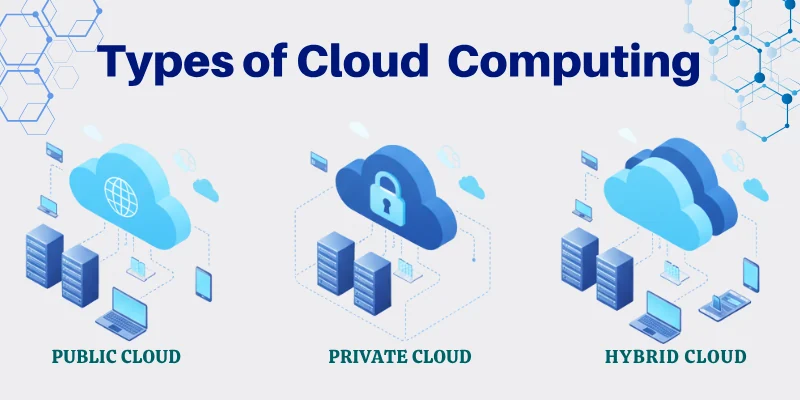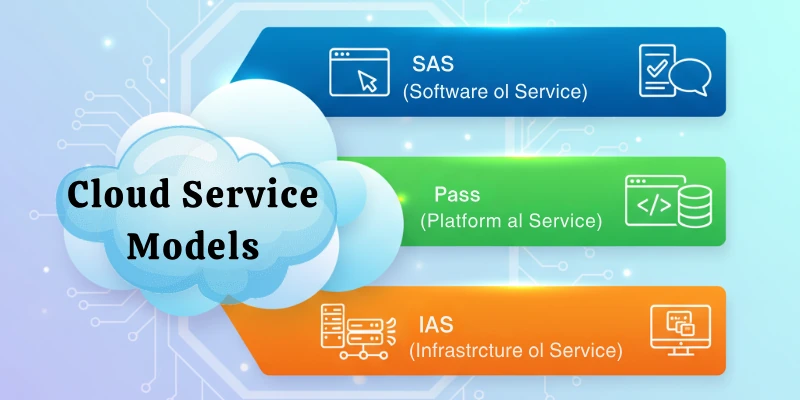Types of Cloud Computing: Deployment Models & Cloud Models
Published: 4 Sep 2025
In today’s tech world, “Types of Cloud Computing” is like a map showing different ways we use computer stuff. Imagine having basic building blocks with Infrastructure as a Service (IaaS) or using Software as a Service (SaaS) for easy-access apps.
Exploring these cloud types helps us understand how we can do things smarter and better with computers.
So, guys, without wasting time, let’s dig in.
Types of Cloud Computing
Let’s discover each kind of cloud technology in detail.

1. Infrastructure as a Service (IaaS)
Infrastructure as a Service (IaaS) is a cloud computing model that provides virtualized computing resources over the internet. It offers fundamental building blocks such as virtual machines, storage, and networking, allowing users to create and manage their own IT infrastructure without investing in physical hardware.
Key Features and Benefits
- IaaS enables users to scale resources up or down based on demand, reducing the need for upfront capital expenses.
- It provides flexibility, as users have control over the operating systems and applications running on the infrastructure.
- Additionally, IaaS allows for rapid deployment of computing resources, supporting various workloads and applications.
Use Cases and Examples
- Common use cases for IaaS include hosting websites, running development and testing environments, and supporting scalable applications.
- Examples of IaaS providers include Amazon Web Services (AWS) Elastic Compute Cloud (EC2), Microsoft Azure Virtual Machines, and Google Cloud Compute Engine.
2. Platform as a Service (PaaS)
Platform as a Service (PaaS) is a cloud computing model that delivers a platform allowing users to develop, deploy, and manage applications without dealing with the complexities of underlying infrastructure. PaaS provides a framework that includes development tools, databases, and runtime environments.
Key Features and Benefits
- PaaS simplifies the application development process by providing pre-configured environments, automating tasks like scaling and patching.
- It accelerates development cycles and reduces the time and effort required to manage infrastructure.
- PaaS also fosters collaboration among development teams.
Use Cases and Examples
- PaaS is ideal for developing and deploying web applications, mobile apps, and APIs.
- Examples of PaaS offerings include Heroku, Google App Engine, and Microsoft Azure App Service.
3. Software as a Service (SaaS)
Software as a Service (SaaS) is a cloud computing model that delivers software applications over the internet. Users can access and use the software without the need for installation or maintenance, as it is centrally hosted and managed by the SaaS provider.
Key Features and Benefits
- SaaS eliminates the need for users to handle software updates, patches, and infrastructure management.
- It offers accessibility from anywhere with an internet connection, promoting collaboration and mobility.
- SaaS typically follows a subscription-based pricing model.
Use Cases and Examples
- Common SaaS applications include email services like Gmail, customer relationship management (CRM) systems like Salesforce, and productivity tools like Microsoft 365 and Google Workspace.
4. Function as a Service (FaaS) / Serverless Computing
Function as a Service (FaaS), also known as Serverless Computing, is a cloud computing model where developers can execute individual functions or pieces of code in response to events without managing the underlying server infrastructure. The cloud provider automatically handles the scaling and execution of functions.
Key Features and Benefits
- FaaS allows developers to focus solely on writing code without worrying about server management.
- It offers cost efficiency by charging based on the actual execution of functions.
- FaaS is highly scalable, responding dynamically to the number of incoming requests.
Use Cases and Examples
- FaaS is suitable for event-driven applications, real-time data processing, and microservices architectures.
- Examples of FaaS platforms include AWS Lambda, Azure Functions, and Google Cloud Functions.
Deployment Models
In the dynamic landscape of cloud computing, various deployment models cater to diverse organizational needs, offering distinct advantages and considerations.
Understanding these models is crucial for businesses seeking optimal solutions for their computing requirements.
1. Public Cloud
The Public Cloud is a deployment model where computing services, including virtual machines, storage, and applications, are delivered by third-party providers over the internet. In this model, resources are shared among multiple users and organizations on a pay-as-you-go basis, promoting cost efficiency and accessibility.
Advantages and Considerations
- Public Clouds offer cost-effective scalability, eliminating the need for upfront infrastructure investments.
- They provide flexibility and accessibility, allowing users to access resources from any location with an internet connection.
- However, considerations include potential security concerns due to shared infrastructure and limited customization options compared to private clouds.
Popular Public Cloud Providers
- Leading public cloud providers include Amazon Web Services (AWS), known for its vast service offerings.
- Microsoft Azure, offering a comprehensive suite of cloud solutions.
- Google Cloud Platform (GCP), known for its data analytics and machine learning capabilities.
- IBM Cloud, providing enterprise-grade services.
- Oracle Cloud, specializing in database solutions.
2. Private Cloud
Private Cloud is a deployment model where computing resources are dedicated to a single organization. These resources can be hosted on-premises or by a third-party provider, offering enhanced security, control, and customization compared to public clouds. Private clouds are suitable for organizations with specific compliance or regulatory requirements.
Advantages and Considerations
- Private Clouds provide a higher level of security and customization, making them ideal for industries with stringent regulatory compliance needs.
- Organizations maintain control over their infrastructure, ensuring a tailored environment.
- However, considerations include higher upfront costs, the need for skilled personnel, and potentially limited scalability compared to public clouds.
Examples of Private Cloud Deployments
- Private clouds can be implemented using on-premises solutions such as VMware or OpenStack.
- Alternatively, organizations can opt for third-party providers offering dedicated cloud environments, such as IBM Cloud Dedicated, VMware Cloud on AWS, or Microsoft Azure Dedicated Host.
3. Hybrid Cloud
Hybrid Cloud is a deployment model that integrates elements of both public and private clouds. It allows data and applications to move seamlessly between these environments, providing flexibility and optimization of computing resources. Hybrid cloud architectures often involve the use of orchestration tools for efficient workload management.
Advantages and Considerations
- Hybrid Clouds offer flexibility, scalability, and the ability to leverage the benefits of both public and private clouds.
- They allow organizations to meet specific workload requirements, balance cost considerations, and address regulatory compliance.
- Considerations include the complexity of managing hybrid environments and potential challenges in data integration.
Real-World Scenarios Where Hybrid Cloud Is Beneficial
- Hybrid cloud is beneficial in scenarios where organizations need to maintain sensitive data on a private cloud while utilizing the scalability of the public cloud for variable workloads.
- It is also useful for businesses with seasonal or unpredictable computing demands, allowing them to scale resources as needed.
- Examples include disaster recovery solutions, data backup, and applications that require both on-premises and cloud resources.
Cloud Service Models
The “types of cloud computing” outline the diverse functionalities within the cloud computing paradigm, while “cloud service models” detail how these services are delivered and the level of control users have over the underlying infrastructure.

So, lets cover cloud services in detail.
- IaaS (Infrastructure as a Service): Provides virtualized computing resources over the internet, allowing users to manage and control the infrastructure, including virtual machines, storage, and networking.
- PaaS (Platform as a Service): Offers a platform that includes development tools, databases, and runtime environments, allowing users to develop, deploy, and manage applications without dealing with the underlying infrastructure.
- SaaS (Software as a Service): Delivers software applications over the internet, allowing users to access and use the software without the need for installation or maintenance.
Considerations for Choosing Cloud Services
Let’s delve into three fundamental aspects crucial for choosing the right cloud services:
- Security
- Scalability
- Cost
These considerations not only shape the foundation of a robust cloud strategy but also pave the way for strategic decision-making, enabling businesses to thrive in the digital era.
1. Security
Data Protection: Ensure robust mechanisms for safeguarding data from unauthorized access and loss. Implement encryption protocols for data in transit and at rest.
Compliance and Regulations: Verify compliance with industry-specific regulations (e.g., GDPR, HIPAA). Confirm adherence to data residency and international legal requirements.
Authentication and Authorization: Implement multi-factor authentication. Define clear access controls and permissions.
Incident Response and Monitoring: Assess incident response capabilities and monitoring tools. Ensure timely notification and resolution of security incidents.
2. Scalability
Automatic Scaling: Confirm automatic scaling to handle workload fluctuations. Evaluate the speed of scaling up or down based on demand.
Resource Availability: Ensure redundant and highly available infrastructure. Assess flexibility in adding or removing resources.
Performance Monitoring: Use monitoring tools for real-time performance tracking. Set up alerts for potential performance issues.
Load Balancing: Evaluate load balancing capabilities for traffic distribution. Ensure seamless failover mechanisms for application availability.
3. Cost
Transparent Pricing Model: Understand the provider’s pricing structure. Look for transparency in costs, including data transfer and additional services.
Resource Optimization: Optimize costs using reserved instances, spot instances, or auto-scaling. Regularly review and adjust resources based on usage patterns.
Hidden Costs: Be aware of potential hidden costs, such as data transfer fees. Regularly review billing reports for cost optimization.
Forecasting and Budgeting: Use forecasting tools to estimate future usage and costs. Establish a budgeting strategy for financial predictability.
Conclusion
In conclusion, “Types of Cloud Computing” encompass Infrastructure as a Service (IaaS), Platform as a Service (PaaS), Software as a Service (SaaS), and Function as a Service (FaaS)/Serverless Computing.
Each type caters to specific needs, offering flexibility, streamlined development, accessibility, and innovative coding approaches. Embracing these cloud models opens doors to a dynamic digital landscape, where adaptability and efficiency pave the way for future advancements in computing.
FAQs
Here are some of the most commonly asked questions related to types of cloud computing:
The main types are IaaS (Infrastructure as a Service), PaaS (Platform as a Service), SaaS (Software as a Service), and FaaS (Function as a Service), also called serverless computing. IaaS provides the basic building blocks like servers and storage. PaaS gives developers tools to build and deploy apps. SaaS offers complete software to end users, while FaaS runs code on demand without managing servers.
Cloud computing is highly scalable, letting businesses grow or shrink resources as needed. It saves money by cutting hardware costs. It also provides flexibility to work from anywhere. Teams can collaborate faster and more efficiently.
Yes, there are a few drawbacks. Security risks can arise if data is not well protected. Internet dependency means services may not work without a stable connection. Customization is also limited compared to owning your own systems.
IaaS gives access to infrastructure like servers, storage, and networks that businesses can manage themselves. SaaS, on the other hand, provides ready-made software applications that users can access online. With IaaS, users control more, while SaaS handles everything for them. The choice depends on business needs.
Yes, cloud computing often saves money. It removes the need for expensive upfront hardware purchases. Businesses only pay for what they use, which makes it flexible. Different pricing models also allow companies to manage costs better.

- Be Respectful
- Stay Relevant
- Stay Positive
- True Feedback
- Encourage Discussion
- Avoid Spamming
- No Fake News
- Don't Copy-Paste
- No Personal Attacks

- Be Respectful
- Stay Relevant
- Stay Positive
- True Feedback
- Encourage Discussion
- Avoid Spamming
- No Fake News
- Don't Copy-Paste
- No Personal Attacks





